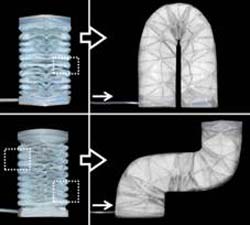Machines based on paper and driven by air have been created by scientists at Harvard University in the USA

Flexible Paper Robots
The fact that paper can bend but not stretch is the key to this remarkable invention, published today in the journal Advanced Functional Materials. Led by Prof. George Whitesides, the researchers have encased a paper sheet in an air-tight elastic material derived from silicones, sometimes called silicon rubbers. On one side of the paper, the silicone is laced with tiny air channels.
As air is pumped into the channels (termed PneuNets), the rubbery material on that side expands, forcing the paper to bend. Postdoctoral researcher Ramses Martinez likens the structures to balloons, “When the balloon part of the structure expands it doesn’t become round (as does a child’s balloon), but adopts more complex shapes in response to the constraints imposed by the paper sheets.”
Indeed, quite complicated shapes and movements can be created by simply altering the pattern of channels and by folding the paper in a process the researchers liken to origami. “The methods we developed are astonishingly simple for the complex motions that they generate. Once we understood the materials to use, the best procedures for fabrication and the kinds of designs that worked best.”
Actuators are what scientists call devices that move or change shape in response to some input and are the moving parts of robots. In their Adv. Funct. Mater. paper, the researchers given examples of contracting actuators (the video shows a worm-like one, but some resembling paper lanterns are also demonstrated), elongating actuators, and pleated bellows. One bellows only 8.2 grams itself is shown to lift a 1 kilogram weight – as shown in the image (fig 6 in the article). Restricting movement further by gluing folds or fastening them together with paper strips can cause the shapes to turn corners or twist as they expand. The scientists drew inspiration from the motions of starfish, worms and squid, but used pneumatics and compressed air rather than muscles.
The publication discusses the use of polyester/cellulose paper and a tough siloxane elastomer called Ecoflex®, but Prof. Whitesides and his group have also used materials such as cotton cloth, fiber, and nylon or metallic mesh as the non-stretching base. The production is simple: a mold is used to create pneumatic channels in the elastomer, which is then bonded to elastomer-soaked paper. Compressed air is pumped into the channels through a small valve. Alternatively, for bellows-type operation, a pleated cylinder of paper is soaked in elastomer, the cylinder is capped, and air is pumped into the centre of the cylinder. A strip of elastomer linking the caps ensures the paper returns fully to its original shape and size on the removal of air.
The work combines Prof. Whitesides’ previous experience of “squishy” robots using silicon-based materials and pneumatic activation with his development of paper as a support for tiny, low-cost, ‘microfluidic’ analytical devices.
Dr. Martinez is enthusiastic about the future for the paper robots, “We hope these structures can be developed into assistants for humans. Unlike the types of (machines) robots used in assembly lines (which are designed to be very strong and fast, but they are also very dangerous for humans to be around when they are operating), these actuators can be more ‘human-friendly’. They might, thus, provide ‘extra fingers or hands’ for surgeons, or handle easily damaged structures, such as eggs or fruit.” Use in disaster relief, where ability for machines to navigate complex pathways would be advantageous, is also envisaged. By adding such things as light sources, or metal wires to allow electrical conductivity, potential applications are considerably broadened.
The scientists wish to acknowledge support in part by The Defence Advanced Research Projects Agency (DARPA) and the US Department of Energy.
R. V. Martinez, C. R. Fish, X. Chen, and G. M. Whitesides, “Elastomeric Origami: Programmable Paper–Elastomer Composites as Pneumatic Actuators”, Adv. Funct. Mater. 2012, Vol. 13, DOI: adfm.201202978.
Contacts:
Prof. G. M. Whitesides, Dr. R. V. Martinez
Department of Chemistry and Chemical Biology, Harvard University, 12 Oxford St, Cambridge, MA 02138, USA
gwhitesides@gmwgroup.harvard.edu; rmartinez@gmwgroup.harvard.edu
http://gmwgroup.harvard.edu/
Peter Reuell, Harvard University Press Officer
peter_reuell@harvard.edu
Eric Mazzacone, DARPA Public Affairs Officer
Eric.Mazzacone@darpa.mil
The article is available at http://doi.wiley.com/10.1002/adma.20120172978
Media Contact
More Information:
http://www.wiley-vch.deAll latest news from the category: Materials Sciences
Materials management deals with the research, development, manufacturing and processing of raw and industrial materials. Key aspects here are biological and medical issues, which play an increasingly important role in this field.
innovations-report offers in-depth articles related to the development and application of materials and the structure and properties of new materials.
Newest articles

Superradiant atoms could push the boundaries of how precisely time can be measured
Superradiant atoms can help us measure time more precisely than ever. In a new study, researchers from the University of Copenhagen present a new method for measuring the time interval,…

Ion thermoelectric conversion devices for near room temperature
The electrode sheet of the thermoelectric device consists of ionic hydrogel, which is sandwiched between the electrodes to form, and the Prussian blue on the electrode undergoes a redox reaction…

Zap Energy achieves 37-million-degree temperatures in a compact device
New publication reports record electron temperatures for a small-scale, sheared-flow-stabilized Z-pinch fusion device. In the nine decades since humans first produced fusion reactions, only a few fusion technologies have demonstrated…





















